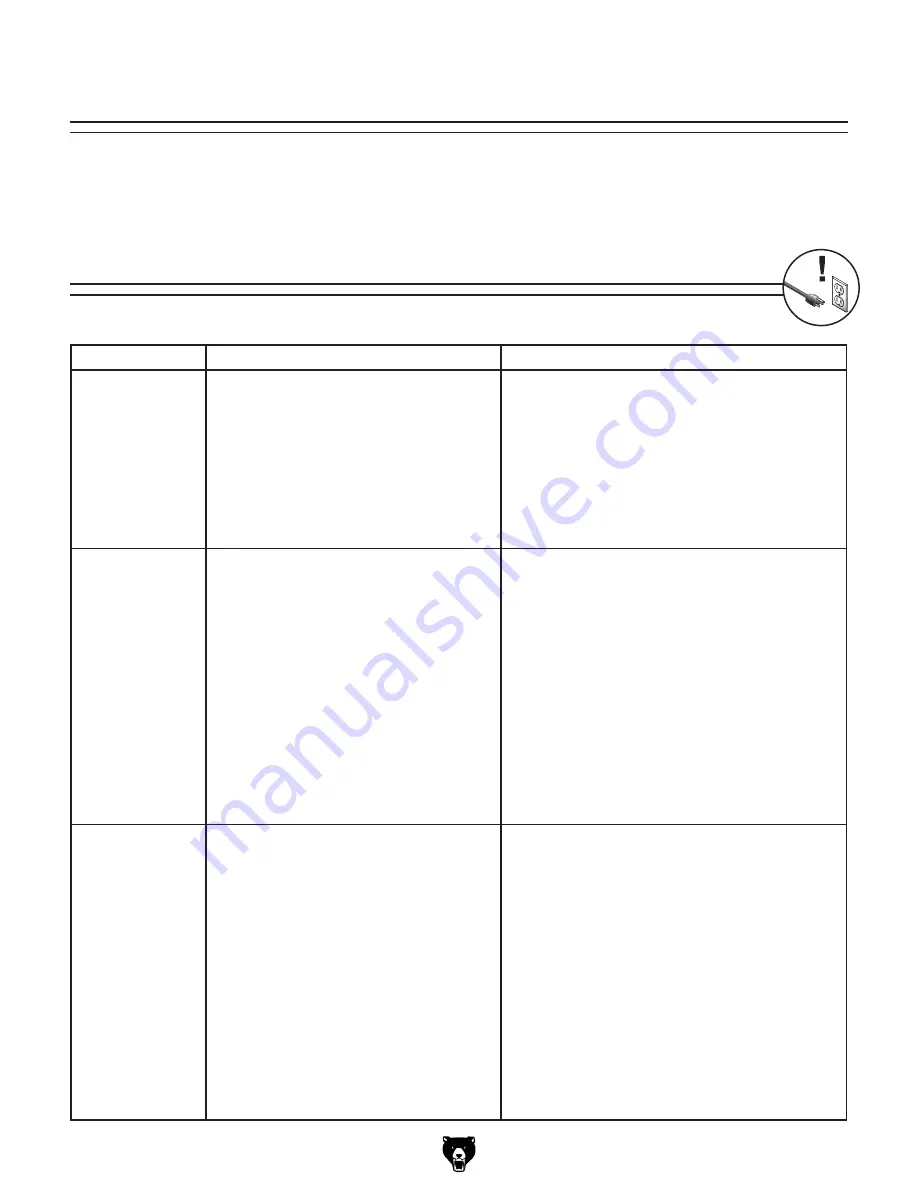
-50-
Model G4000 (Mfg. Since 8/09)
SECTiON 7: SERviCE
Troubleshooting
Motor & Electrical
symptom
possible Cause
possible solution
Machine does not
start or a breaker
trips.
1. power supply switched oFF or at fault.
2. plug/receptacle at fault/wired wrong.
3. Motor connection wired wrong.
4. Wall circuit breaker tripped.
5. Wiring open/has high resistance.
6. spindle switch at fault.
7. start capacitor at fault.
8. Centrifugal switch at fault.
9. Motor at fault.
1. Ensure power supply is on/has correct voltage.
2. test for good contacts; correct the wiring.
3. Correct motor wiring connections (
page 55).
4. Ensure circuit size is correct/replace weak breaker.
5. Check/fix broken, disconnected, or corroded wires.
6. replace switch.
7. test/replace if faulty.
8. Adjust/replace centrifugal switch.
9. test/repair/replace.
Machine stalls or is
underpowered.
1. Feed rate/cutting speed too fast.
2. Wrong workpiece material.
3. Belt(s) slipping.
4. Motor wired incorrectly.
5. plug/receptacle at fault.
6. pulley slipping on shaft.
7. Motor bearings at fault.
8. Machine undersized for task.
9. Motor overheated.
10. spindle rotation switch at fault.
11. run capacitor at fault.
12. Motor at fault.
13. Centrifugal switch at fault.
1. decrease feed rate/cutting speed.
2. use correct type/size of metal.
3. tension/replace belt(s); ensure pulleys are aligned.
4. Wire motor correctly (
page 55).
5. test for good contacts/correct wiring.
6. replace loose pulley/shaft.
7. test/repair/replace.
8. use sharp tools at correct angle; reduce feed rate/
depth of cut; use cutting fluid if possible.
9. Clean motor, let cool, and reduce workload.
10. test/replace switch.
11. test/repair/replace.
12. test/repair/replace.
13. Adjust/replace centrifugal switch if available.
Machine has
vibration or noisy
operation.
1. Workpiece not held firmly in chuck/
faceplate.
2. Motor or component loose.
3. spindle belt worn or loose.
4. pulley loose.
5. incorrectly mounted to workbench.
6. Motor fan rubbing on fan cover.
7. Bit chattering.
8. Workpiece or chuck at fault.
9. Motor bearings at fault.
10. Centrifugal switch.
11. Quick change gears at fault.
1. Correctly secure workpiece in chuck/faceplate.
2. inspect/replace damaged bolts/nuts, and re-tighten
with thread locking fluid.
3. inspect/replace belts.
4. realign/replace shaft, pulley, set screw, and key.
5. Adjust feet, shim, or tighten mounting hardware.
6. Fix/replace fan cover; replace loose/damaged fan.
7. replace/sharpen bit; index bit to workpiece; use
correct feed rate and spindle speed.
8. Center workpiece in chuck or face plate; replace
defective chuck.
9. test by rotating shaft, replace if grinding.
10. replace switch.
11. replace bad gear(s)/bearing(s).
Review the troubleshooting and procedures in this section if a problem develops with your machine. If you
need replacement parts or additional help with a procedure, call our Technical Support at (570) 546-9663.
Note: Please gather the serial number and manufacture date of your machine before calling.








































